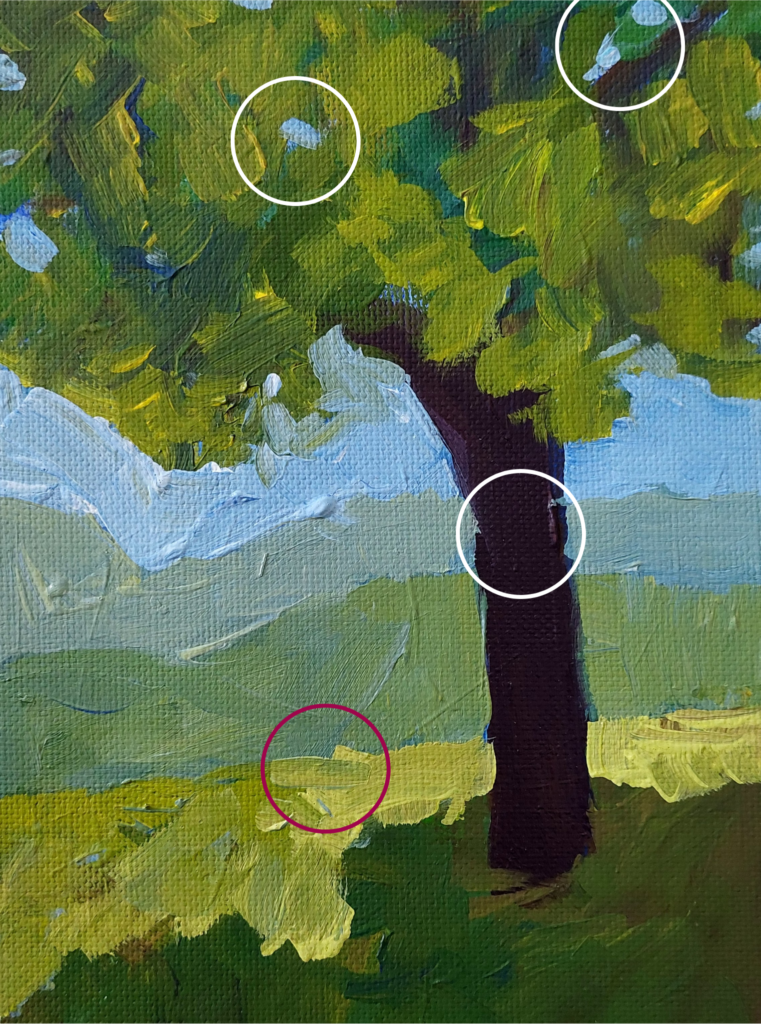Painting skies has lots of leeway for mistakes and creativity. Clouds, colors, feelings – the variety that skies offer is astonishing and inspiring. However, no matter the type of sky you paint, there is one steadfast rule that needs to be followed. The sky is in the background. The sky is the background. It needs to be behind everything else. Because that is the reality of our physical world. Weather can get in front of foreground objects – as fog, but the sky itself is behind everything.
This leads us to our our number one mistake when painting skies – having sky bits on TOP of other subject matter. Here is an example:
The three white circles highlight spots in the demo painting where the sky (background) is now painted ON TOP of a subject matter, when it should be behind it. Notice in the tree, the shape of the dabs of blue paint really accentuate the fact that the blue is on top. The tree trunk has sky bits on top of (= in front of) the tree. To the viewer, this doesn’t work!
This applies to more than skies. The red circle shows a correct layering of the foreground being ON TOP of the middle ground.
What this Causes
Sky bits on top of the non-sky subject matter causes a break in the trompe l’oeil effect. Because this isn’t something that occurs in our reality, we suddenly have our belief in the pictorial space ruined.
How this Easily Happens
How does this mistake when painting skies happen so frequently? Let’s take the example of painting a tree in a simple landscape. We want to put the tree in front of the sky, so we paint the sky, then the tree. Then as we proceed further in the painting process, we decide to adjust the sky. Let’s say we lighten the value up. Then we look at the sky bits we can see through the tree, and we realize we need to lighten those up too! After dabbing a few bits of paint onto the canvas, we have achieved a lighter sky consistently, but we have now put the physical paint of the sky ON TOP of the tree. Whoops.
How to Fix This
The easiest way is to know that you will need to repaint the non-sky subject matter (like a tree) again, after the sky is fully painted. Save some of the color that you used, and just make sure that all the edges where sky and tree meet have tree painted on top. (In the image above, this was done with bright green highlight being put on top of the sky color on the left side.) Or, once the sky is painted, and you put the subject matter on top, don’t adjust the sky again near the subject.
One way to try and avoid making this mistake when painting skies – is to not have the new sky value touch the subject matter. I would avoid this “fix” because I find it to be worse than the problem. You end with a space where your edges don’t touch and it looks like all your paint is afraid of your other paint. This is probably the second most common problem I see in with my art students. Luckily, as soon as you see it, it is easy to fix- just re-paint the foreground edge again. As you paint more, keeping this in mind, you will soon stop making this mistake.
REBEL – and Break This Rule?
Now to admit the next thing. I think breaking this rule can be really fun. But, like anything else in art-rule-breaking, it needs to look intentional or it just looks like a mistake. When we make this painting mistake when painting skies, we are messing with the rules of the pictorial space that we just set up for the viewer. And, it causes a back and forth movement between the pictorial space being representative and abstraction. This can create a vibration feeling for the viewer. However, if the whole painting is tightly representational and just the sky bits were added on top, it will just read as a mistake, and ruin the trompe l’oeil effect you were trying to achieve.
Many contemporary art paintings play with edges of subject matter interacting together. It is a lot of fun, and try it for yourself if you haven’t yet. Here is a sneak peak at a painting I am working on where I am playing around with this concept:
Vocabulary:
trompe l’oeil
Trompe l’oeil is an artistic term for the highly realistic optical illusion of three-dimensional space and objects on a two-dimensional surface. Trompe l’oeil, which is most often associated with painting, tricks the viewer into perceiving painted objects or spaces as real.
Pictorial space





